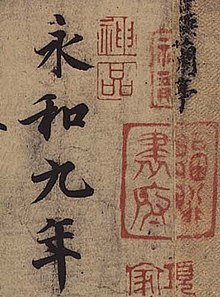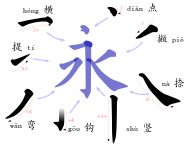Chinese calligraphy
| Chinese calligraphy 中國 書法 |
|
|---|---|
| Calligraphic copy - 新婦 地 黃 湯 帖 , Xīnfù dìhuáng tāngtiě - Wang Xianzhi | |
| Chinese name | |
| Long characters | 書法 |
| Abbreviation | 书法 |
| Pinyin | Shūfǎ |
| Wade-Giles | Shufa |
| Jyutping | Syu 1 faat 3 |
| Japanese name | |
| Kanji | 書 道 |
| Kana | し ょ ど う |
| Hepburn | shodō |
| Korean name | |
| Hangeul | 서예 |
| Hanja | 書 藝 |
| RR | Seoye |
| MR | Sŏye |
The Chinese calligraphy ( Chinese 中國 書法 / 中国 书法 , Pinyin zhōngguó shūfǎ ) is an art movement that is closely related to Chinese painting . In both arts are the same tools, the four treasures of the study used: writing brushes , Inkstick , ink stone and paper . It is therefore not surprising that famous Chinese calligraphers were often also great painters.
One of the most famous Chinese calligraphers was Wang Xizhi , whose style, after more than a millennium, is still the basis of calligraphy lessons today. Calligraphy was seen as an important part of training and should also allow conclusions to be drawn about personality. Wáng Xīzhī replaced the right-angled style with italic lines that enable individual design. Since then, calligraphy has been valid in China alongside Wéiqíl - also known as Go , painting and music as the fourth of the classical arts ( 四 藝 / 四 艺 , sìyì ) - also known in Chinese as - Qín , Qí , Shū , Huà ; 琴棋 書畫 / 琴棋 书画 - " Guqin , Weiqi , calligraphy , painting" ,.
The high prestige of calligraphy is shown, among other things, in the fact that even Chinese emperors tried to excel in calligraphy. Emperor Song Huizong , whose style of slim gold ( 金 , shòujīn ) represents a high point of Chinese calligraphy, made the greatest progress in this art .
Basis of Chinese calligraphy are the "eight principles of the character yǒng" - 永 , yǒng means "eternity" ' - ( 永字八法 , Yǒngzì Bāfǎ ):
側 (侧) cè, namely 點 (点) diǎn, period
勒 lè, namely 橫 (横) héng, cross
努 nǔ, namely 直 / 豎 (竖) zhí / shù, straight ahead
趯 tì, namely 鉤 (钩) gōu, hook
策 cè, namely 挑 tiāo, taking off
掠 lüè, namely 撇 piě, oblique
啄 zhuó, namely 短 撇 duǎn piě, peck
磔 zhé, namely 捺 nà, pushing forward
- The eight principles of the sign Yǒng - 永
The eight principles represent the most important basic strokes of the calligrapher; they describe the five strokes that make up the character.
Chinese Calligraphy Categories
| German | Alternatively | Langz. | Abbrev. | Pinyin | Kanji | Hepburn | Hangeul | RR | Quốc Ngữ |
|---|---|---|---|---|---|---|---|---|---|
| Seal script | - | 篆書 | 篆书 | Zhuànshū | 篆書 | Tensho | 전서 | Jeonseo | Triện thư |
| Italics | Semi-italics | 行書 | 行书 | Xngshu | 行書 | Gyōsho | 행서 | Haengseo | Hành thư |
| Grass script | Concept font | 草書 | 草书 | Cǎoshū | 草書 | Sosho | 초서 | Choseo | Thảo thư |
| Chancellery | Official font | 隸書 | 隶书 | Lìshu | 隸書 | Reisho | 예서 | Yeseo | Lệ thư |
| Rule script | Block letters | 楷書 | 楷书 | Kǎishu | 楷書 | Kaisho | 해서 | Haeseo | Khải thư |
See also
literature
- Anett Dippner, Thorsten Benkel: Signs of Aesthetics: Art, culture and calligraphy between tradition and variety of meanings . In: Series of writings on cultural studies . tape 78 . Dr. Kovač, 2009, ISBN 978-3-8300-3764-4 , ISSN 1435-6589 .
- Rong Fang Cao, Klaus-Dieter Hartig: Chinese calligraphy: with brush and ink. Instructions and templates. Augustus-Verlag, Augsburg 1995, ISBN 3-8043-0241-6 .
- Bonan Guo: Introduction to Chinese Calligraphy . 1st edition. Verlag für Fremdsprachige Literatur, Peking 1995, ISBN 7-119-01446-3 (Chinese: Zhong guo shu fa ru men . Translated by Menglian Liu).
- Shi Bo: Encres de Chine. Les maîtres de la calligraphie chinoise . 1st edition. éditions Alternatives, Paris 2003, ISBN 2-86227-364-3 (French).
- Jinchang Fei: Xinhua Xiezi Zidian: Chinese characters . Shang wu yin shu guan, Beijing 2004, ISBN 7-100-03247-4 (Chinese: 新华 写字 字典 . A dictionary with 2500 Chinese characters with stroke order and pinyin transcription, but all written in characters.).
Web links
- Official website - learning platform - www.hkedcity.net (Chinese, English)













